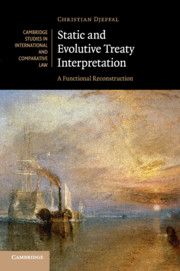
-
Select format
-
- Publisher:
- Cambridge University Press
- Publication date:
- December 2015
- December 2015
- ISBN:
- 9781316339558
- 9781107118317
- 9781107543645
- Dimensions:
- (228 x 152 mm)
- Weight & Pages:
- 0.78kg, 452 Pages
- Dimensions:
- (229 x 152 mm)
- Weight & Pages:
- 0.65kg, 452 Pages
You may already have access via personal or institutional login
Book description
How should international treaties be interpreted over time? This book offers fresh insights on this age-old question. The Vienna Convention on the Law of Treaties (VCLT) sets out the rules for interpretation, stipulating that treaties should be interpreted inter alia according to the 'ordinary meaning' of the text. Evolutive interpretation has been considered since the times of Gentili and Grotius, but this is the first book to systematically address what evolutive interpretation looks like in reality. It sets out to address how and under what circumstances it can be said that the interpretation of a treaty evolves, and under what circumstances it remains static. With the VCLT as its point of departure, this study develops a functional reconstruction of the rules of treaty interpretation, and explores and analyses how the International Court of Justice and the European Court of Human Rights have approached the issue.
Contents
Metrics
Altmetric attention score
Full text views
Full text views help Loading metrics...
Loading metrics...
* Views captured on Cambridge Core between #date#. This data will be updated every 24 hours.
Usage data cannot currently be displayed.
Accessibility standard: Unknown
Why this information is here
This section outlines the accessibility features of this content - including support for screen readers, full keyboard navigation and high-contrast display options. This may not be relevant for you.
Accessibility Information
Accessibility compliance for the PDF of this book is currently unknown and may be updated in the future.


